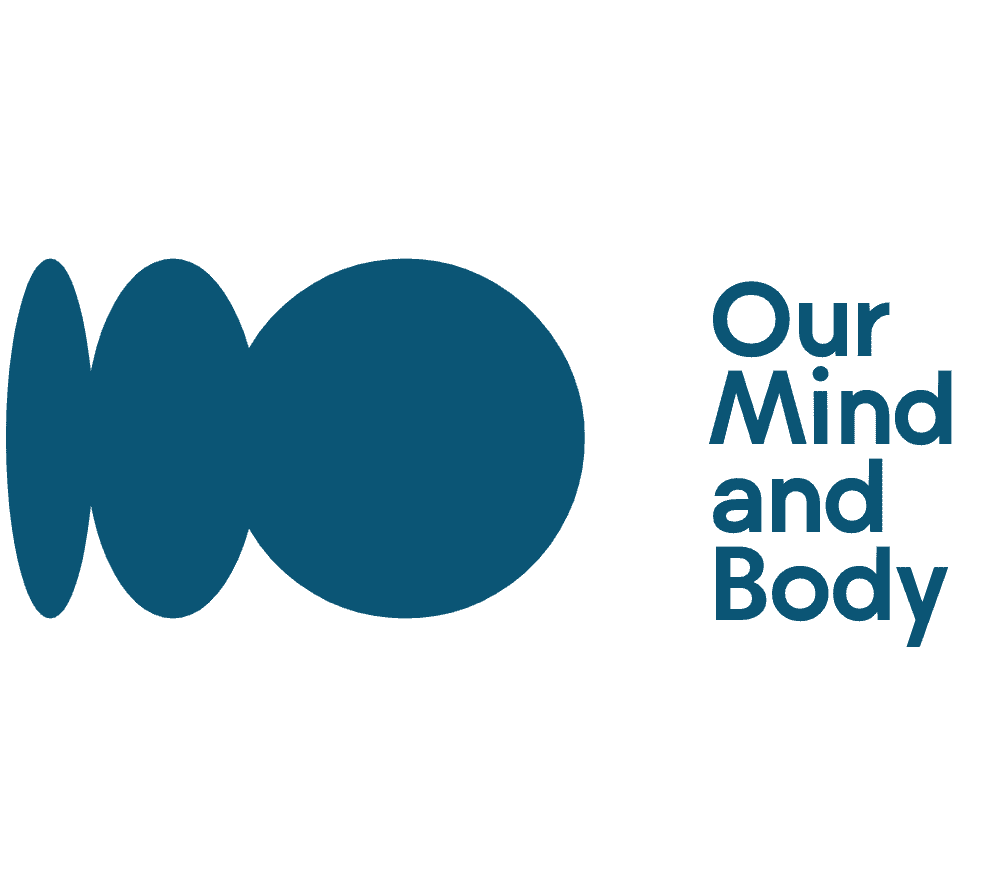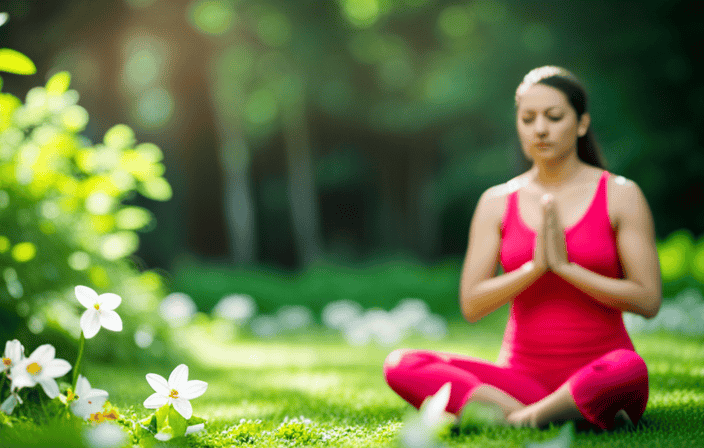Yoga
Holistic Healing Through Yoga Therapy: Objectives, Benefits & Differences
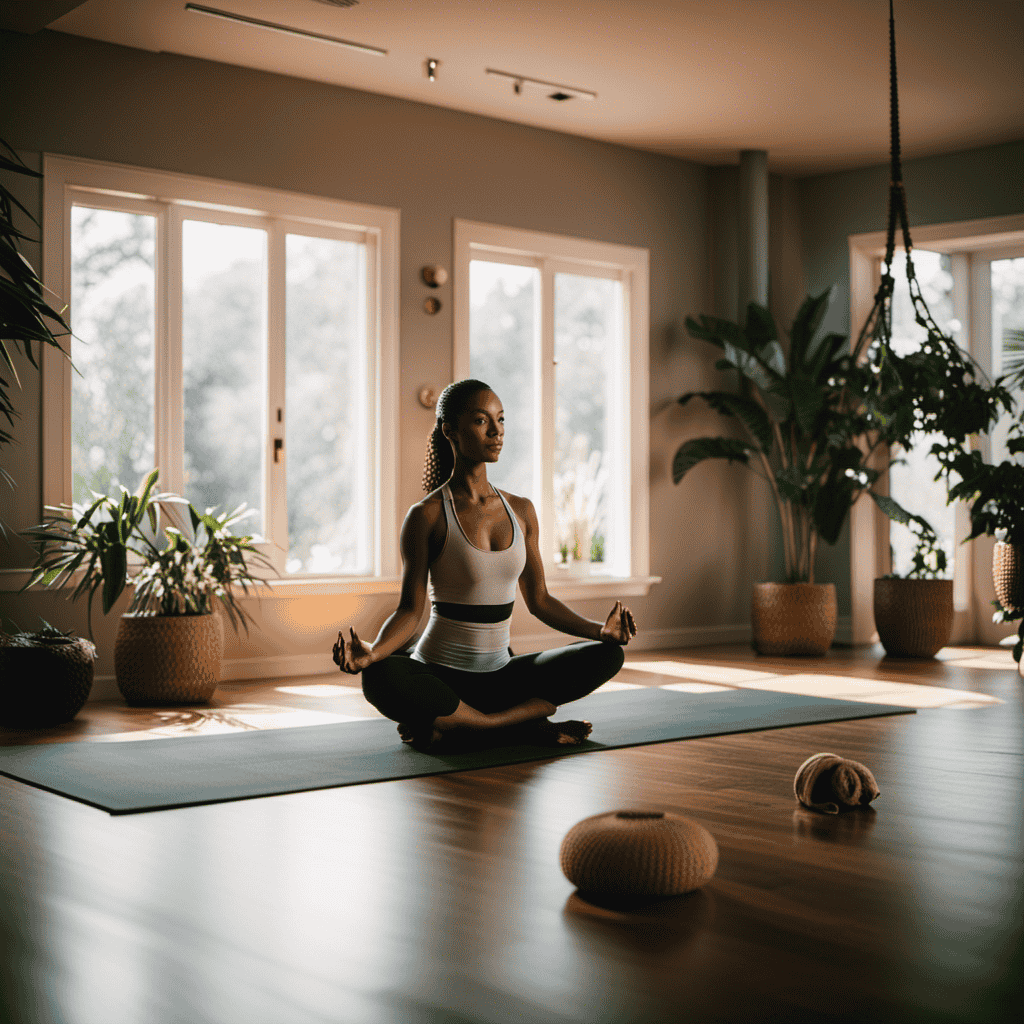
Did you know that holistic healing through yoga therapy can improve overall well-being by addressing physical, mental, and emotional health?
With a focus on specific conditions like epilepsy and cerebral palsy, yoga therapy offers personalized recommendations for individuals seeking healing.
By incorporating stretching, mindfulness, and relaxation techniques, it enhances flexibility, strength, and self-awareness while promoting stress management and emotional well-being.
In this article, we will explore the objectives, benefits, and differences of holistic healing through yoga therapy.
Get ready to discover the power of this transformative practice.
Key Takeaways
- Yoga therapy takes a holistic approach to healing, targeting both physical and mental well-being.
- It provides personalized and effective healing techniques tailored to individual needs.
- Yoga therapy enhances flexibility, strength, and mindfulness.
- It promotes self-awareness, stress management, and overall well-being.
What is it?
Yoga therapy is a holistic approach to healing that targets both physical and mental well-being. It goes beyond traditional yoga practices by incorporating specific techniques to address individual needs and conditions.
The benefits of yoga therapy are vast, as it not only improves overall well-being but also promotes self-awareness and stress management. Through a combination of physical postures, breathing exercises, and meditation, yoga therapy enhances flexibility, strength, and mindfulness.
It provides a safe and nurturing space for individuals to explore their own bodies and emotions, allowing for deep healing and transformation. The techniques used in yoga therapy are tailored to the specific needs of each person, ensuring a personalized and effective approach to healing.
Whether it’s addressing physical ailments or mental health issues, yoga therapy offers a unique and comprehensive way to achieve holistic healing.
Specific Conditions
Addressing specific conditions, such as epilepsy and cerebral palsy, involves recommendations and targeted approaches for individuals with these conditions.
When it comes to epilepsy, yoga therapy can help reduce the frequency and intensity of seizures by promoting relaxation and stress management.
For cerebral palsy, yoga therapy focuses on improving muscle tone, flexibility, and coordination.
Here are four key recommendations and benefits of yoga therapy for these conditions:
-
Gentle movements and stretches can help improve mobility and reduce muscle stiffness.
-
Breathing exercises and meditation techniques can enhance relaxation and reduce anxiety.
-
Mind-body connection practices can promote self-awareness and improve overall well-being.
-
A holistic approach to yoga therapy addresses both physical and mental aspects, helping individuals with epilepsy and cerebral palsy achieve a better quality of life.
By incorporating these recommendations and adopting a holistic approach, yoga therapy can effectively support individuals with epilepsy and cerebral palsy in managing their specific conditions.
Physical Health
Improving physical health involves focusing on specific physical conditions and utilizing stretching and intensity to enhance overall well-being. When it comes to therapeutic yoga, the aim is to target and address these conditions through a holistic approach.
By engaging in regular practice, individuals can improve flexibility and strength, which are both essential components of physical well-being. Yoga therapy takes into account the mind-body connection and aims to promote harmony and balance within the individual.
It recognizes that physical health is not just about the absence of illness or injury, but also about achieving a state of optimal function and vitality. Through the practice of therapeutic yoga, individuals can develop a greater sense of self-awareness, improve their ability to manage stress, and experience the healing effects of a holistic approach to physical well-being.
Mental and Emotional Health
Enhancing my mental and emotional well-being through therapeutic yoga has been a transformative experience. Yoga therapy has helped me address mental health issues and improve my emotional well-being. By incorporating mindfulness and relaxation techniques, yoga therapy has enhanced my self-awareness and stress management skills. It has provided me with a safe space to explore and understand my emotions on a deeper level. Through regular practice, I have learned to be more present in the moment and to cultivate a sense of inner peace and calm. The holistic healing effects of yoga therapy have not only improved my mental and emotional health, but they have also positively impacted other areas of my life. I am grateful for the powerful healing benefits that yoga therapy has brought into my life.
| Enhancing Mindfulness | Self Awareness and Stress Management |
|---|---|
| Yoga therapy helps me stay present in the moment and cultivate mindfulness. | It has deepened my self-awareness and helped me better understand my reactions and emotions. |
| By incorporating relaxation techniques, yoga therapy has provided me with effective tools to manage stress. | It has empowered me to take control of my stress levels and find inner peace amidst chaos. |
Incorporating therapeutic yoga into my routine has been a game-changer for my physical health.
Yoga therapy techniques have played a crucial role in improving my overall well-being.
The guidance and expertise of yoga instructors in therapy have been invaluable. They have not only taught me various poses and breathing exercises but also provided a safe and supportive environment for my healing journey.
Through yoga therapy, I have been able to target specific physical conditions and enhance my flexibility and strength.
The holistic approach of yoga therapy has not only improved my physical health but also addressed my mental and emotional well-being.
The mindfulness and relaxation techniques have enhanced my self-awareness and stress management skills.
Yoga therapy has truly been a transformative experience, bringing about a sense of balance and harmony in my life.
Frequently Asked Questions
What are the potential limitations or risks of practicing yoga therapy?
In my experience, practicing yoga therapy may have some limitations and risks. It’s important to be aware of your physical limitations and consult with a qualified yoga therapist. Overexertion or improper alignment can lead to injury.
Can yoga therapy be used as a standalone treatment or is it typically used in conjunction with other forms of therapy?
Yoga therapy can be used as a standalone treatment or in combination with other forms of therapy. It offers a holistic approach to healing, addressing physical, mental, and emotional well-being.
How long does it typically take to see results from yoga therapy?
Typically, the timeframe for seeing results from yoga therapy varies depending on individual factors such as the severity of the condition, consistency of practice, and overall health. It can take weeks to months to experience significant improvements in physical, mental, and emotional well-being. However, even small changes in these areas can be noticed early on. It’s important to remember that yoga therapy takes a holistic approach and focuses on long-term healing rather than quick fixes.
Are there any specific precautions or modifications that need to be considered for individuals with certain medical conditions?
When it comes to individuals with certain medical conditions, precautions and modifications are essential in yoga therapy. It’s important to consider their specific needs and adapt the practice accordingly for a safe and effective experience.
Is yoga therapy suitable for people of all ages and fitness levels?
Yes, yoga therapy is suitable for people of all ages and fitness levels. It can be tailored to meet the specific needs and abilities of individuals, allowing them to experience the benefits of yoga therapy regardless of their age or fitness level.
Conclusion
In conclusion, yoga therapy is a powerful and holistic approach to healing. It targets physical, mental, and emotional well-being. By incorporating stretching, mindfulness, and relaxation techniques, it improves flexibility, strength, self-awareness, and stress management.
Like a gentle breeze guiding us towards tranquility, yoga therapy offers a pathway to balance and health. It is a nurturing practice that embraces the whole person, providing a space for healing and growth.
With its unique objectives and benefits, yoga therapy offers a transformative journey towards overall well-being.
Meet Nadi, the soulful writer and explorer of inner realms who graces OurMindAndBody.com with her profound insights and heartfelt wisdom. With a profound passion for mindfulness, meditation, and spiritual growth, Nadi weaves words that touch the hearts and minds of readers, leaving a lasting impact on their well-being journey.
Rooted in a background of philosophy and psychology, Nadi’s curiosity about the human mind and the mysteries of the soul led her on a transformative path of self-discovery. Drawn to the transformative power of mindfulness and meditation, she embarked on a quest to understand the intricacies of these practices, not only for her own growth but also to inspire others to embark on their own inner journeys.
Yoga
The Power Of Regular Movement For Optimal Health
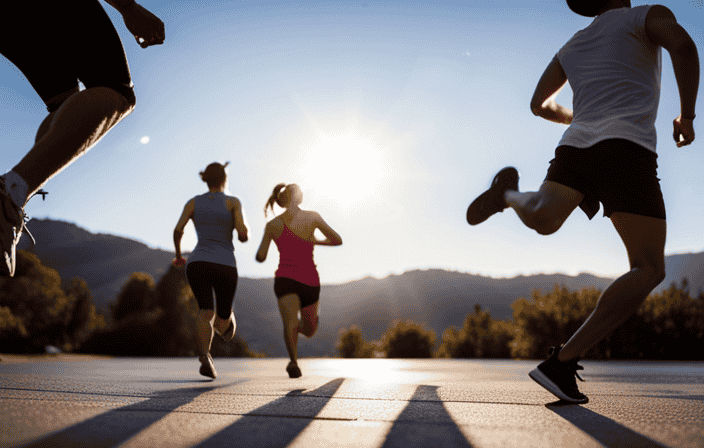
As the adage states, ‘Movement is medicine.’ Indeed, consistent physical activity is essential for attaining peak health.
It’s not just about hitting the gym or going for a run – it’s about incorporating physical activity into our daily lives.
In this article, we will explore the various benefits of regular movement, from improving cardiovascular health and brain function to strengthening respiratory functions and reducing stress levels.
So let’s dive in and discover the power of regular movement for our overall well-being.
Key Takeaways
- Regular movement improves cardiovascular health and helps maintain weight and mental health.
- Physical activities boost cognitive function and help grow new brain cells and connections.
- Regular movement strengthens muscles, improves endurance, and benefits respiratory functions.
- Regular movement reduces stress levels, improves sleep quality, and promotes a healthier lymphatic system.
Why is it important?
Regular movement is important because it improves cardiovascular health, enhances brain function, supports respiratory and lymphatic system health, reduces stress levels, and improves sleep quality.
Engaging in regular physical activity not only strengthens our muscles and improves our cardiovascular system, but it also helps us maintain a healthy weight and mental health. Additionally, daily exercise improves heart function, blood circulation, and respiratory functions. It promotes a healthier lymphatic system, which is crucial for our immune system.
Regular movement also reduces stress levels in the body, releases hormones that improve mood, and enhances deep sleep, reducing stress and anxiety. By prioritizing regular movement, we can prevent the negative effects of a static lifestyle and enjoy the long-term health benefits that come with it.
So let’s get moving and prioritize our health!
Benefits of Movement
Engaging in physical activity regularly enhances various aspects of my well-being. It’s incredible how movement positively impacts my cardiovascular system, brain health, respiratory functions, lymphatic system, and stress levels. Regular exercise not only improves my cardiovascular health and blood circulation, but also helps maintain a healthy weight and enhances my mental well-being. It’s amazing how physical activities can boost cognitive function and improve work productivity. Additionally, regular movement strengthens my muscles, increases endurance, and reduces breathlessness. By moving my body, I am assisting my lymphatic system in eliminating toxins and fighting infections. The release of hormones during exercise also helps reduce stress levels and promotes a better quality of sleep. Overall, regular movement is the key to optimal health and well-being.
| Benefits of Movement |
|---|
| – Improved cardiovascular health |
| – Enhanced brain function and cognitive abilities |
| – Strengthened respiratory system |
| – Healthier lymphatic system |
| – Reduced stress levels and improved sleep quality |
Cardiovascular Health
I love how exercising regularly improves my cardiovascular health and keeps my heart strong. By engaging in regular movement, such as going to the gym or biking, I am able to build muscles and enhance my cardiovascular system. Not only does this help me maintain a healthy weight, but it also improves my heart function and blood circulation.
Investing in quality gym equipment is essential for my motivation and to ensure that I reap the full health benefits. Regular exercise not only improves my physical health, but it also boosts my cognitive function. I am amazed at how physical activities can actually help grow new brain cells and connections, leading to improved brain health and work productivity.
So, let’s keep moving and reap the amazing benefits for our cardiovascular health and overall well-being!
Brain Function
Exercising regularly not only improves my cardiovascular health, but it also enhances my brain function and cognitive abilities. Physical activities have a profound impact on the brain, allowing it to change and improve throughout life. Here are four ways regular exercise benefits my brain:
-
Boosts cognitive function: Engaging in physical activities stimulates the brain, improving memory, attention, and problem-solving skills. It enhances overall cognitive function, allowing me to think more clearly and efficiently.
-
Increases neuroplasticity: Regular exercise helps grow new brain cells and strengthen connections between them. This enhances learning abilities and improves overall brain health.
-
Enhances work productivity: Engaging in physical activities during work hours can enhance cognitive abilities, leading to increased focus, creativity, and productivity.
-
Improves mood and mental well-being: Exercise releases hormones that improve mood and promote a sense of well-being. It reduces symptoms of anxiety and depression, allowing me to feel happier and more motivated.
By prioritizing regular movement, I am not only improving my cardiovascular health but also enhancing my brain function, leading to a healthier, sharper, and more productive mind.
Respiratory Benefits
Improved respiratory functions are a direct result of consistent physical activity. Regular movement increases endurance and reduces breathlessness. When we engage in physical activities, our muscles become stronger and require less oxygen for energy production. This means that we can perform activities without feeling out of breath easily.
Additionally, regular movement benefits overall respiratory health by improving lung capacity and efficiency. By incorporating exercises like cardio, running, or swimming into our routine, we can strengthen our respiratory muscles and enhance our lung function. These improvements in respiratory health not only support our daily activities but also contribute to our overall well-being.
So let’s keep moving and enjoy the benefits of a healthier respiratory system.
Lymphatic System
Engaging in physical activities helps move lymph fluid in the body, supporting a healthier lymphatic system. The lymphatic system plays a crucial role in our immune system, as it helps remove toxins, waste products, and unwanted substances from our body.
Regular movement, such as exercise, promotes the circulation of lymph fluid, aiding in the transport of white blood cells that fight infections. By keeping the lymphatic system active, we enhance its overall function and ensure a more efficient immune response.
Moreover, physical activities also help prevent the buildup of lymph fluid, reducing the risk of swelling and lymphedema. So, whether it’s going for a brisk walk, doing yoga, or participating in sports, incorporating regular movement into our routine is essential for maintaining a healthy lymphatic system and supporting our overall well-being.
Stress Reduction and Sleep
Now that we understand how regular movement benefits our lymphatic system, let’s shift our focus to another incredible advantage: stress reduction and improved sleep.
Incorporating regular exercise into our daily routine can significantly reduce stress levels in our bodies. When we engage in physical activities, our brains release cortisol, a hormone that helps manage stress. Additionally, exercise helps the brain focus and cope with stress, leading to a better overall mood.
But that’s not all – regular movement also enhances the quality of our sleep. By engaging in physical activity, we stimulate deep sleep, reducing stress and anxiety. So, not only does regular movement provide us with physical health benefits, but it also promotes mental and emotional well-being.
Let’s continue on this journey of optimal health by exploring the power of regular movement for stress reduction and improved sleep.
Negative Effects of Inactivity
I can’t emphasize enough the negative effects of a static lifestyle on my physical, mental, and emotional health.
Extended periods of inactivity are detrimental to my body, leading to a decline in overall well-being. When I don’t engage in regular movement, my muscles weaken, my cardiovascular system suffers, and my risk for various diseases increases.
Not only that, but a lack of physical activity also affects my mental health, causing feelings of low mood and decreased cognitive abilities. Emotionally, I may experience higher stress levels and poor sleep quality.
It’s important to remember that exercises, sports, and swimming promote movement and prevent these health issues. By incorporating regular movement into my daily routine, I can significantly improve my physical, mental, and emotional health, saving myself from medical interventions and enjoying a higher quality of life.
Exercise for Overall Health
By incorporating exercise into my daily routine, I can improve my overall well-being and prevent the need for medical interventions. Regular movement is essential for maintaining optimal health and preventing various diseases.
Engaging in physical activities such as exercise not only improves muscle strength, stability, and coordination but also supports immune function and detoxification. It is a holistic approach to wellness that benefits both the body and the mind.
Exercise has been proven to enhance cardiovascular health, reduce the risk of diseases, and promote longevity. Moreover, regular physical activity supports brain function and cognitive abilities, improving focus, productivity, and overall mental well-being.
By prioritizing exercise, I am taking control of my health and investing in a healthier future. So, let’s get moving and reap the incredible benefits of regular exercise!
Motivation and Equipment
Let’s explore the importance of having proper motivation and quality equipment for effective workouts and improved overall well-being.
When it comes to regular movement, having the right motivation and equipment is essential for achieving optimal health. Here are three key reasons why motivation and quality equipment are crucial:
-
Stay motivated: Having the right motivation is essential for sticking to your exercise routine. Quality equipment can make your workouts more enjoyable and help you stay committed to your fitness goals.
-
Maximize results: Investing in quality gym equipment ensures that you can perform exercises effectively and safely. This allows you to maximize your results and achieve your fitness goals more efficiently.
-
Enhance overall well-being: Regular exercise with proper equipment not only improves physical health but also boosts mental well-being. The right equipment can make your workouts more challenging and enjoyable, leading to increased motivation and a sense of accomplishment.
By prioritizing motivation and investing in quality equipment, you can make regular movement a sustainable and rewarding part of your lifestyle. So, let’s stay motivated and equip ourselves for optimal health!
Long-Term Health Benefits
Investing in regular exercise and quality gym equipment leads to improved cardiovascular health, enhanced cognitive abilities, and a stronger immune system over time.
Regular movement has numerous long-term health benefits that can significantly improve our overall well-being.
Engaging in regular physical activities helps reduce the risk of cardiovascular diseases by strengthening the heart and improving blood circulation.
Additionally, exercise enhances brain function and cognitive abilities, promoting better focus, memory, and productivity. It also supports respiratory health by increasing endurance and reducing breathlessness.
Regular movement aids in the movement of lymph fluid, supporting a healthier lymphatic system and a stronger immune system.
Moreover, exercise reduces stress levels, releases mood-enhancing hormones, and improves sleep quality.
By investing in regular movement, we can experience these long-term health benefits and enjoy a healthier and more fulfilling life.
Frequently Asked Questions
What are some examples of exercises that promote regular movement?
Some examples of exercises that promote regular movement include biking, swimming, engaging in sports, and routine exercises with quality gym equipment. These activities improve cardiovascular health, brain function, respiratory functions, and overall well-being.
Can regular movement help with weight management?
Regular movement is a game-changer for weight management! It revs up your metabolism, torches calories, and builds lean muscle. Combined with a healthy diet, regular movement is the key to shedding pounds and keeping them off. So get moving and watch the pounds melt away!
How does regular movement improve brain function?
Regular movement improves brain function by increasing blood flow and oxygen to the brain, promoting the growth of new brain cells, and enhancing cognitive abilities. It also improves focus, productivity, and overall mental well-being.
What are some specific respiratory benefits that come from regular movement?
Regular movement provides several respiratory benefits. It increases endurance, strengthens muscles, and improves overall respiratory functions. This leads to reduced breathlessness and better oxygen utilization, promoting healthier breathing and preventing feeling out of breath easily.
How does regular movement support the immune system?
Regular movement supports the immune system by increasing blood circulation and promoting the movement of lymphatic fluid. This helps to distribute immune cells throughout the body, enhancing their ability to fight off infections and diseases.
Conclusion
In conclusion, regular movement is the key to unlocking optimal health. The benefits are astounding!
Not only does it improve cardiovascular health, but it also boosts brain function and strengthens respiratory functions.
The negative effects of a sedentary lifestyle are too great to ignore. By investing in quality gym equipment, we can stay motivated and maximize the health benefits of regular movement.
So let’s get moving and experience the transformative power of exercise. Trust me, it’s a game-changer!
Say hello to Cypress, the soulful wordsmith behind the insightful articles at OurMindAndBody.com. Cypress is a gifted writer who weaves words with grace and precision, using language as a powerful tool to inspire, heal, and uplift the spirits of readers.
With a background in literature and a passion for personal growth, Cypress brings a unique perspective to the world of well-being and spirituality. Having experienced the transformative effects of meditation and yoga firsthand, Cypress is deeply connected to the essence of these practices and their potential to enrich lives.
Yoga
Stretching Beyond Limits: The Power Of 4-Person Acro Yoga
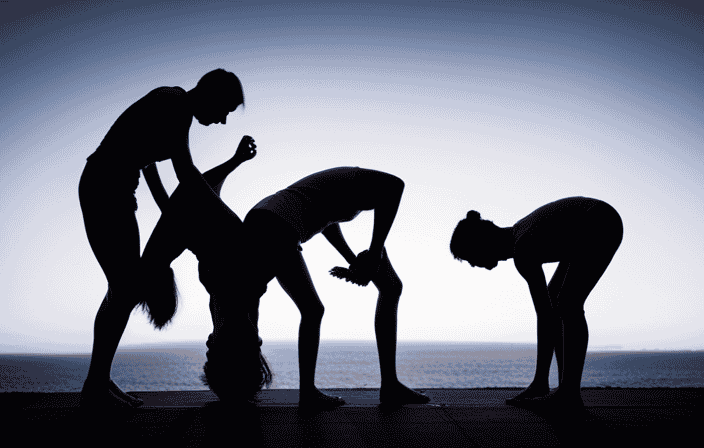
Picture the thrill of gliding through the skies, overcoming gravity with your own physical power and the backing of your teammates. This is the realm of Acro Yoga, a blend of yoga and acrobatics that challenges the limits of our perceived capabilities.
In this article, we explore the power of 4-person Acro Yoga, a practice that stretches beyond limits, both physically and mentally. Join me as we uncover the transformative benefits of this dynamic and awe-inspiring practice.
Key Takeaways
- Combination of yoga and acrobatics
- Requires focus, concentration, teamwork, and cooperation
- Improves strength and flexibility
- Transforms the body, mind, and spirit
What is Acro Yoga?
Acro Yoga is a combination of yoga and acrobatics that originated in India over 2,000 years ago and has recently gained popularity in the western world. It is a unique practice that combines the mindfulness and relaxation of traditional yoga with the strength and excitement of acrobatics.
In Acro Yoga, two or more people work together to create beautiful and challenging poses that push their bodies to new limits. It requires focus, concentration, teamwork, and cooperation.
The benefits of Acro Yoga are numerous. It improves strength and flexibility by using arms and legs to support body weight and by stretching into new positions. It also improves balance by challenging practitioners to maintain balance while supported by their partners.
Additionally, Acro Yoga enhances communication skills by requiring constant communication with partners about poses and feelings. Overall, Acro Yoga is a powerful practice that can transform not only the body but also the mind and spirit.
Benefits of Acro Yoga
Improved strength and flexibility are just a few of the benefits I have experienced through practicing this unique form of yoga. Acro yoga combines the elements of yoga and acrobatics, requiring focus, concentration, teamwork, and cooperation. It originated in India over 2,000 years ago and has recently gained popularity in the western world. The physical demands of acro yoga help build muscle strength as poses require using arms and legs to support body weight. Additionally, stretching into new positions improves flexibility. Another benefit is improved balance, as poses require maintaining balance while being supported by a partner. Acro yoga also enhances communication skills, as it requires constant communication with your partner about poses and feelings. It is truly a holistic practice that benefits not only the body but also the mind and emotions.
| Benefits | Description |
|---|---|
| Improved Strength | Poses require using arms and legs to support body weight, building muscle strength. |
| Improved Flexibility | Stretching into new positions improves flexibility. |
| Improved Balance | Poses require maintaining balance while being supported by a partner, improving proprioception and kinesthesia. |
| Improved Communication | Constant communication with your partner about poses and feelings enhances expression and listening skills. |
Improving Strength and Flexibility
Practicing this unique form of combined yoga and acrobatics has significantly increased my muscle strength and flexibility. The poses in 4-person acro yoga require using my arms and legs to support my body weight, which has built up my muscle strength over time. I can feel the difference in my muscles as they have become more toned and capable of supporting me in challenging positions.
Additionally, stretching into these new positions has improved my flexibility. I can now reach further and move with greater ease. This increased strength and flexibility has not only improved my physical abilities but has also enhanced my overall well-being. I feel more confident and capable in my everyday life, and I am grateful for the benefits that 4-person acro yoga has brought to my body and mind.
Frequently Asked Questions
How long does it take to master 4-person Acro Yoga poses?
Mastering 4-person acro yoga poses can take time and practice. It depends on individual factors such as strength, flexibility, and coordination. With regular training and dedication, it could take several months to a year or more to achieve mastery.
Are there any age restrictions for practicing Acro Yoga?
There are no age restrictions for practicing acro yoga. I’ve seen people of all ages, from children to seniors, participating and benefiting from it. It’s a practice that can be enjoyed by anyone willing to try.
Can Acro Yoga help with weight loss?
Acro yoga can aid in weight loss by improving strength, flexibility, balance, and coordination. The challenging poses require using muscles to support body weight, which can result in calorie burning and increased metabolism.
Are there any specific clothing or equipment requirements for practicing Acro Yoga?
When practicing acro yoga, it’s important to wear comfortable and flexible clothing that allows for free movement. As for equipment, a yoga mat and a spotter are recommended for safety and stability during challenging poses.
Is Acro Yoga suitable for individuals with injuries or physical limitations?
Yes, Acro Yoga can be suitable for individuals with injuries or physical limitations, as it can be modified to accommodate different needs. It is important to communicate with your partner and instructor to ensure safety and proper modifications are made.
Conclusion
In conclusion, Acro Yoga is a transformative practice that goes beyond the physical realm. Through the combination of yoga and acrobatics, individuals are able to stretch beyond their limits and discover new levels of strength, flexibility, and balance.
The power of Acro Yoga lies in its ability to foster communication, teamwork, and cooperation. It enhances not only our physical abilities but also our mental and emotional well-being.
So, if you’re looking to challenge yourself, connect with others, and experience the incredible benefits of this ancient practice, give 4-person Acro Yoga a try. You won’t be disappointed.
Say hello to Cypress, the soulful wordsmith behind the insightful articles at OurMindAndBody.com. Cypress is a gifted writer who weaves words with grace and precision, using language as a powerful tool to inspire, heal, and uplift the spirits of readers.
With a background in literature and a passion for personal growth, Cypress brings a unique perspective to the world of well-being and spirituality. Having experienced the transformative effects of meditation and yoga firsthand, Cypress is deeply connected to the essence of these practices and their potential to enrich lives.
Yoga
Couples’ Perfect Workout: Yoga Poses For Two To Strengthen, Bond, And Energize
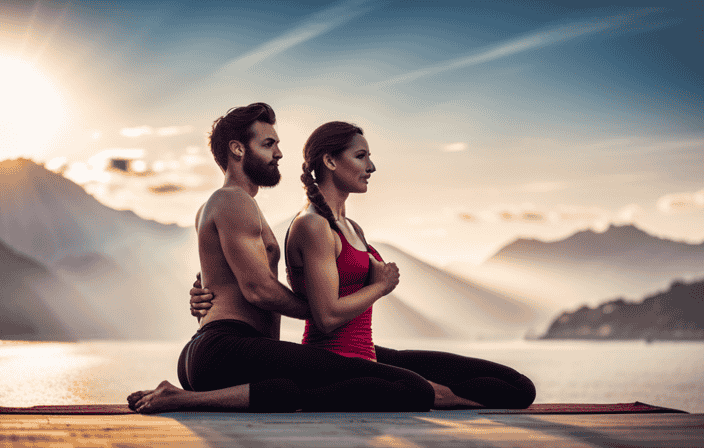
Seeking an enjoyable and efficient method to enhance your connection with your significant other as well as boost your physical health? Search no more than partner yoga poses!
These poses not only provide a challenging and invigorating workout, but they also promote coordination, focus, and overall body strength. From the Flying Bow to the Flying Paschi, there are poses for every couple to try.
So grab your partner and get ready to strengthen, bond, and energize with these amazing yoga poses for two.
Key Takeaways
- Partner yoga provides a comprehensive workout for the entire body and improves overall fitness.
- It fosters a deep connection with a partner and strengthens the emotional bond.
- Partner yoga engages muscles not normally used and improves coordination and focus.
- It deepens stretches and balances, enhances flexibility, and increases heart rate and burns calories.
Yoga Poses for Two
Yoga poses for two people are a great way to strengthen my body, bond with my partner, and energize ourselves.
These poses not only provide a full-body workout but also enhance coordination and focus.
One of my favorite poses is the Flying Bow and Flying Handstand Scorpion. It not only builds strength, flexibility, and balance but also provides a deep shoulder stretch. This pose increases my heart rate and helps burn calories, leaving me feeling invigorated.
Another pose that I enjoy is the Flying Superman. It works out with my partner and helps us build strength, coordination, balance, and flexibility together.
And for a more intimate experience, the Flying Paschi is perfect. This pose requires close physical contact, strengthening our bond and increasing our flexibility.
Overall, yoga poses for two people are a fun and effective way to stay fit, bond with my partner, and energize our bodies.
So, let’s grab our partner and give these poses a try!
Benefits of Partner Yoga
Partner yoga offers a variety of benefits. It improves overall fitness, fosters a deep connection with my partner, and provides a comprehensive workout for my entire body.
Not only does it help me stay fit and healthy, but it also allows me to bond and connect with my partner on a deeper level. The poses require close physical contact, which strengthens our relationship and increases our flexibility.
Partner yoga poses are not only fun and challenging, but they also provide a full-body workout that engages muscles I may not normally use. The deep stretches and balances help improve my coordination and focus, while also increasing my heart rate and burning calories.
So, why not grab my partner and give these poses a try? They are the perfect way to strengthen, bond, and energize together.
Final Thoughts
Why not give these poses a try and experience the benefits of practicing together? Partner yoga poses not only provide a fun and unique way to stay fit and healthy, but they also allow you to bond with your partner on a deeper level. By engaging in these poses, you can enjoy a full-body workout that strengthens your muscles, improves flexibility, and enhances coordination.
Here are three reasons why you should incorporate partner yoga into your fitness routine:
-
Strengthen your bond: Partner yoga requires close physical contact and communication, which can help strengthen the emotional connection between you and your partner. It’s a great opportunity to support and trust each other, deepening your relationship.
-
Enhance your flexibility: Partner yoga poses often involve stretching and reaching further than you could on your own. By working together, you can help each other deepen your stretches and improve flexibility.
-
Energize your practice: Practicing yoga with a partner adds an element of fun and excitement to your workout. It brings a sense of playfulness and motivation, making your yoga session more enjoyable and energizing.
So grab your partner, step onto the mat together, and explore the wonderful world of partner yoga. Strengthen, bond, and energize your relationship while reaping the physical and mental benefits of practicing yoga as a team.
Frequently Asked Questions
How do you modify yoga poses for two people if there is a significant difference in height or flexibility between partners?
To modify yoga poses for two people with a significant difference in height or flexibility, partners can use props like blocks or straps. They can also adjust the position or intensity of the pose to accommodate each other’s abilities.
Can beginners or individuals with limited yoga experience participate in partner yoga poses?
Yes, beginners or individuals with limited yoga experience can participate in partner yoga poses. It’s a great way to learn and grow together, while also increasing strength, flexibility, and bonding with your partner. Give it a try!
Are there any safety precautions or considerations to keep in mind when practicing yoga poses with a partner?
When practicing yoga poses with a partner, it’s important to keep safety in mind. Communicate openly with your partner, listen to your body, and avoid pushing beyond your limits. Proper alignment and gradual progression are key to preventing injuries.
Can partner yoga poses be beneficial for individuals who are not in a romantic relationship?
Partner yoga poses can absolutely benefit individuals who are not in a romantic relationship. They promote trust, communication, and connection with a friend or family member. Plus, they provide a fun and challenging way to enhance flexibility, strength, and overall well-being. Give it a try!
Are there any specific breathing techniques or cues that should be followed during partner yoga poses for optimal results?
During partner yoga poses, it is important to focus on synchronized breathing. This helps deepen the connection between partners and promotes relaxation, allowing for optimal results in strength, flexibility, and overall well-being.
Conclusion
In conclusion, practicing yoga poses for two is like embarking on a captivating dance with your partner. Just as the gentle sway of two bodies in perfect harmony creates a mesmerizing spectacle, these poses allow couples to strengthen their bond while energizing their bodies.
It’s not just about building strength and flexibility, but also about deepening the connection between partners. So, step onto the mat, embrace the beauty of togetherness, and let the magic of partner yoga ignite your souls.
Say hello to Cypress, the soulful wordsmith behind the insightful articles at OurMindAndBody.com. Cypress is a gifted writer who weaves words with grace and precision, using language as a powerful tool to inspire, heal, and uplift the spirits of readers.
With a background in literature and a passion for personal growth, Cypress brings a unique perspective to the world of well-being and spirituality. Having experienced the transformative effects of meditation and yoga firsthand, Cypress is deeply connected to the essence of these practices and their potential to enrich lives.
-

 Aura4 weeks ago
Aura4 weeks agoUnderstanding The Grey Aura: Balance, Neutrality, And Personal Growth
-

 Personal Growth3 months ago
Personal Growth3 months agoThe Power Of Kindness: Cultivating Happiness, Connection, And Personal Growth
-

 Meditation3 weeks ago
Meditation3 weeks agoUnderstanding Spiritual Attacks: Types, Signs, And Protection
-

 Meditation1 month ago
Meditation1 month agoThe Symbolic Significance Of Sand Dollar: Spiritual Meanings And Cultural Connections
-

 Inspiration2 weeks ago
Inspiration2 weeks agoThe Power Of Spiritual Impartation: Empowering Believers And Cultivating Growth
-

 Inspiration3 months ago
Inspiration3 months agoThe Role And Qualities Of A Spiritual Advisor: A Guide On The Path
-

 Spirituality3 months ago
Spirituality3 months agoThe Power Of Spiritual Cleansing: History, Benefits, Techniques, And Personal Experiences
-

 Spirituality3 months ago
Spirituality3 months agoRecognizing And Overcoming Spiritual Attacks: A Guide To Protection
